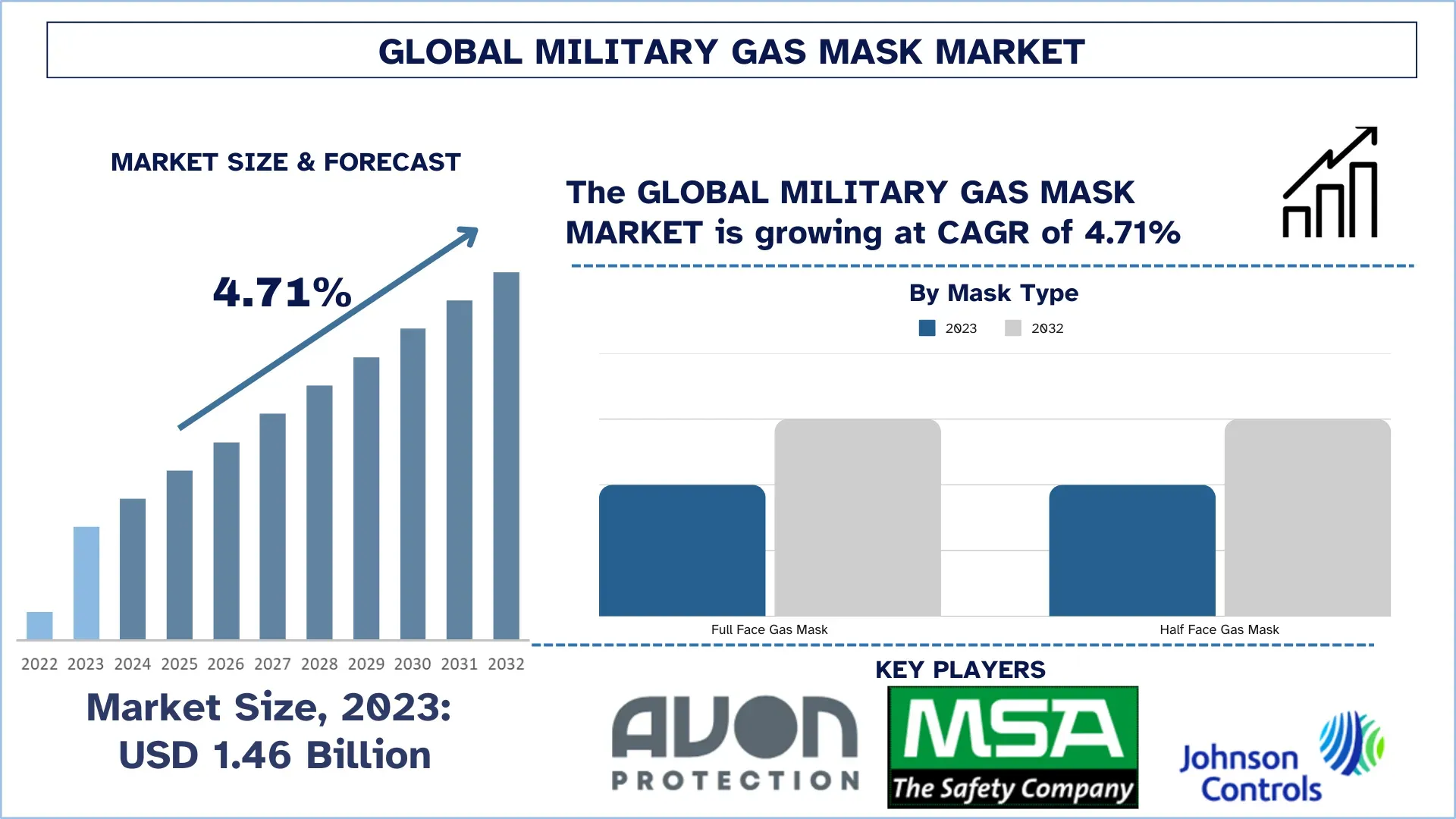The North American military gas mask market has seen a gradual increase in the historic period and is expected to behave in the same manner in the forecast period. The primary reason behind this is the increasing defense budgets, upgrading of military equipment, and the transformation of warfare, which includes chemical, biological, radiological, and nuclear (CBRN) threats to them. The U.S. military has one of the largest defense budgets in the world. Therefore, its heavy investments in safety and protection gear are meant to ensure the safety of personnel when they are in a hazardous environment, such as severely protective gear, including gas masks.
According to the UnivDatos, as per their “Military Gas Mask Market” report, the global market was valued at USD 1.46 billion in 2023, growing at a CAGR of about 4.71% during the forecast period from 2024-2032 to reach USD billion by 2032.
The use of asymmetric warfare and unpredictability in global conflict patterns is very popular these days and has also increased the need for more sophisticated protective solutions, which continue to encourage market growth.
The rapid rise in the use of chemical and biological agents in modern warfare and their incorporation into terrorism is one of the major causes for the expanded potential military gas mask market. The increase in such global threats, such as weapons of mass destruction (WMDs) and the use of chemical agents in state and non-state actor conflicts, has amplified efforts in providing armed military personnel with high-performance gas masks to minimize any threats occurring from them. The North American militaries, through their probation-increasing emphasis on individual soldier protection and operational readiness haulage, will build up ever more complex, easier-to-use, and effective gas mask solutions.
For More Detailed Analysis in PDF Format, Visit- https://univdatos.com/reports/military-gas-mask-market?popup=report-enquiry
Key Applications and Technological Advancements in Gas Mask Systems
The North American military gas mask market thus caters to wide-ranging applications, including battlefield operations, tactical missions, and military training environments. Asymmetric warfare is very much preferred by armies, and they increasingly use gas masks for protection against CBRN attacks, toxic chemicals, biological pathogens, and even nuclear radiation exposure in certain situations. For example, specialized gas masks are used in riot control situations or where airborne toxins threaten urban areas.
Technologically, the gas mask currently experiences rapid change in filtration technologies, comfort, and fully integrated systems. The military personnel's newly introduced gas masks include the best filters which can neutralize a broad range of chemical, biological, and particulate contaminants, making it possible for the wearer not to worry about his or her safety for long periods. On top of that, the forthcoming generation of gas masks is geared towards ending the life of integrated communication systems, whereby soldiers can maintain proper communication even in environments contaminated by toxic agents.
One of the most notable trends that the market is currently witnessing is the invention of smart technologies in gas masks. Such smart masks can be designed to contain sensors for detecting harmful gases, monitoring the respiratory rate of the soldier wearing it, as well as filtering air based on these parameters. Thus, these make the safety of soldiers increase efficiency in operations, especially in high-stress, dynamic environments associated with combat. For instance, the American military has provided the M50 Joint Service General Purpose Mask (JSGPM), an advanced system that offers increased protection, comfort, and communication integration under hostile conditions.
Explore the Comprehensive Research - https://univdatos.com/reports/military-gas-mask-market
Regulatory and Safety Standards Impacting Adoption
Military gas mask adoption in North America is a function of prevailing domestic and international regulations governing soldier safety, equipment performance, and NATO standards. The DoD (Department of Defense) plays a proactive role in the procurement guidelines and requirements for gas mask systems in the United States to ensure stringent criteria for chemical protection, ease of use, and durability.
Besides DoD specifications, the National Institute for Occupational Safety and Health (NIOSH) sets standards for the approval of respiratory protective devices. NIOSH-approved masks ensure that military personnel are protected from toxic exposure in a variety of combat situations. Another aspect that spurred current advancement and innovation is that the U.S. Army is bracing toward upgrading its CBRN defense capabilities by acquiring advanced gas masks.
For instance, the acquisition of military-grade protective gear, including gas masks as part of its ongoing chemical, biological, radiological, and nuclear defense measures, would largely be in similar standards to what the Canadian Forces require. The fit of the masks, user comfort, and efficient filtration systems have been some of the recent advances incorporated by the Canadian Forces to keep operational effectiveness in contaminated environments.
Related Reports:
Remote Operated Vehicle Market: Current Analysis and Forecast (2022-2030)
Helicopter Simulator Market: Current Analysis and Forecast (2022-2028)
COPD and Asthma Diagnostic and Monitoring Devices Market: Current Analysis and Forecast (2021-2027)
Nitrile Gloves Market: Current Analysis and Forecast (2024-2032)
Gas Diffusion Electrode Market: Current Analysis and Forecast (2024-2032)
Conclusion
The North American military gas mask market has changed due to the threats from CBRN are getting worse, the technology is evolving, and there is a greater need for better protection. With the advancements in filtration systems to smart technologies that make it easier for both use and transport, the market is primed for steady growth. The momentum for further innovative developmental initiatives relates to the continued expenditure by the U.S. and Canadian militaries on the modernization programs, upgrades into which these gas masks have been incorporated with other defense technologies. Given the implementation of such technologies, soldiers are protected in increasingly complex and unpredictable battlefields. The trend is thus good for the future of military gas masks in North America, along with some more improvements yet to come to cater to modern warfare, while the market pushes for better safety, comfort, and increased operational efficiency.
Contact Us:
UnivDatos
Contact Number - +19787330253
Email - contact@univdatos.com
Website - www.univdatos.com
